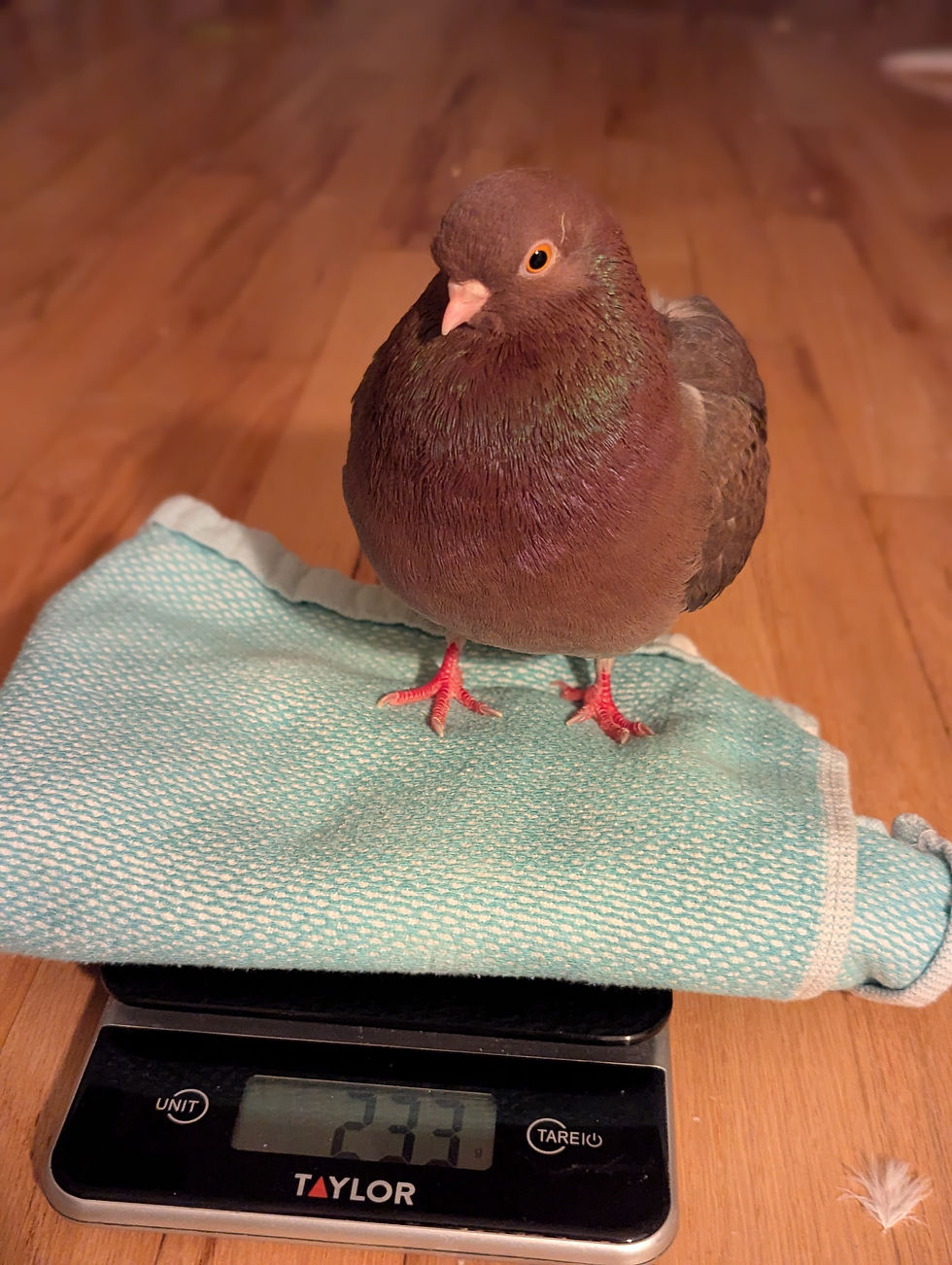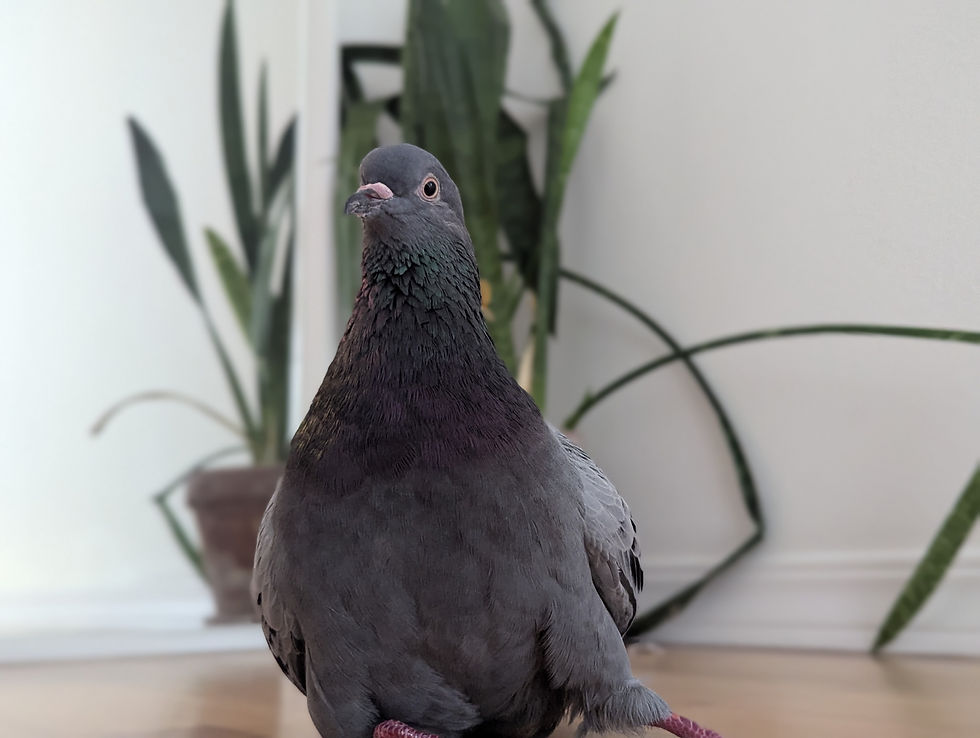Why Would a Pigeon Need Rescue?
- Stormi Hoebelheinrich
- Aug 31
- 5 min read
When I talk about our pigeon rescue work, one of the most common questions I hear is: “Why would a pigeon need to be rescued?” It’s a fair question. Many people are used to seeing flocks of “wild” pigeons in city centers and assume they are thriving on their own. But the reality is far more complicated and often heartbreaking.
Pigeons are vulnerable in many ways, and countless of them face situations where human care is the only thing that stands between survival and suffering. Here are some of the main reasons why pigeons need rescuing:
The Reality of City (Feral) Pigeons
The pigeons you see on sidewalks, rooftops, and bridges aren’t truly wild, they are feral descendants of domesticated birds that relied on human stewardship for thousands of years. While they’ve adjusted to life outside the cage or loft, they remain highly vulnerable to injuries, illnesses, and hazards caused by urban environments.
Injuries from cars, windows, and animal attacks are extremely common.
“String foot” (caused by entanglement in litter like string, thread, or fishing line) cuts off circulation and often leads to infections, amputations, or death.
Lack of veterinary care when sick or injured leaves these birds with few options unless a rescuer intervenes.
Domestic Breeds: Fancy, Sport, and Meat Pigeons
Not all pigeons you see are feral. There are domestic breeds that simply cannot survive in the wild. People are often surprised to learn just how many different types of pigeons exist, bred for sport, show, or food.
Racing pigeons are released in large numbers during races, sometimes hundreds of miles from home. While racers claim the birds can find their way back, studies show 30–60% never do. Those that survive often end up starving, injured, or lost in cities. And when owners are contacted, they rarely want these “failed” birds back.
Culls from breeding programs are sometimes released intentionally left to die without dignity because they are considered undesirable.
“Wedding release doves” (typically juvenile homing pigeons), while intended to be a happy symbol, face a particularly grim reality. Often they are young, white birds raised in cages and released for the first time at ceremonies. With no survival skills and highly visible to predators, many don’t survive the day.
Meat market pigeons (bred for squab) occasionally escape or are released. These birds are large, heavy, and slow, making them easy prey. Life outside captivity is short and brutal for them.
Abandoned Pets and Overlooked Animals
Pigeons can live 20–30 years, which makes them a long-term commitment. Sadly, many become unwanted when owners lose interest, pass away, or can no longer care for them. Unlike cats or dogs, unwanted pigeons have no formal shelter system to fall back on.
The Legal Gap in Care
Perhaps the most shocking reality is that there is no official system of care for pigeons.
Wildlife rehabbers are legally prohibited from caring for pigeons in most cases, since they are considered “invasive.” The only option rehabbers are allowed is euthanasia.
Domestic animal shelters like the Humane Society may help if a pigeon is banded (showing it belongs to a racing or homing flock), but otherwise they turn people away.
Well-meaning citizens who find injured pigeons are often directed to wildlife rehab centers, not realizing this is almost always a death sentence for the bird.
This leaves a devastating gap that independent rescuers and sanctuaries like ours are left to fill.
The Human Side of Rescue
For those of us who care, it’s easy to become overwhelmed. Pigeon rescuers can be contacted over 100 times a year about birds in need. While some can be rehabilitated and returned to homes or flocks, many require lifelong sanctuary due to injuries or disabilities.
And sometimes, it’s not just the pigeons who need rescue. The rescuers themselves do, too. Compassion fatigue and burnout are real. Supporting one another is part of sustaining this work. Often times you're helping a pigeon because you're trying to help a fellow pigeon rescuer.
Why Pigeons Need Us
The answer to “why would a pigeon need rescue?” is simple: Because they are vulnerable, overlooked, and often abandoned by the very systems meant to protect animals.
Every pigeon has a story of survival, of resilience, and sometimes, of heartbreak. By stepping in, we give them a chance at life, safety, and dignity.
And that is why pigeon rescue matters. This is why we established Arcadia Avian Refuge.
Stories from the Sanctuary
Here are a few of our pigeons and their stories to illustrate the wide range of backgrounds we see before these birds finally landed at our sanctuary.
Rockette & Rocky

Rocky was found in a Portland neighborhood with half of his wing missing, bloody with an open wound. The cause of his injury, a mystery, likely an animal attack or run-in with machinery. He was able to make a fully recovery, but is flightless and was unable to return to the wild. His wife, Rockette, is a beautiful pigeon, likely a homing pigeon with a history of racing. She is also limited in her ability to fly. Her origin story is less known, but we know it involves being circulated through a number of rescuers before ultimately meeting Rocky and finding a forever home at Arcadia Avian Refuge, thanks to the dedication and pigeon match-making abilities of Charis.
June & Bubba

June and Bubba were part of our seed flock entrusted to us by Cynthia Harris when she generously donated the Aviary at our sanctuary to kick-start Arcadia Avian Refuge. June is a white homing pigeon, likely a lucky survivor of the Wedding Dove Release practice. Her husband, Frank (unpictured) has a damaged wing but manages to fly well enough in the safety of the aviary. Bubba is half "king pigeon," which is an extremely large breed of pigeon typically used for meat, completely unfit for life in the wild. He got this pedigree (and name) from his father, Bubba Dutch, a beloved pet rescued from his fate in the squab industry. Bubba represents a common phenomena, though one we rescuers try our best to prevent, known as an "oops baby" or unintended breeding. We religiously remove eggs from couples and swap them with fakes, preventing such breeding. Miraculously, an egg slips through now and again. In this case, we rescuers must accept responsibility for providing these birds a home.
Dandy

Little Dandy was seized by authorities when his owner was convicted of serious crimes. Dandy is a fancy pigeon breed, likely some variety of roller. We don't know his backstory, but he was seriously ill when he came to us, and required months of dedicated care and treatment. He's healthier now, but is frail and spends his nights luxuriously perched on a heating pad. Because he was likely isolated away from other pigeons in his previous life, he is terrified by other birds and requires special care in the home, away from the general flock, with the company of humans, his stuffed animals, and Jeeves.
Giovanni "Jeeves" Pepperoni

Jeeves fell from his nest at Barbur Transit Center at approximately 2 weeks old. He was unable to move due to severe calcium deficiency and a range of other infections. He was treated and has grown into a health bird (7 years old in Summer 2025!) but his early condition left him with crippled legs, slipped tendon and splayed leg. Health conditions like these are common particularly in the flock at Barbur Transit Center due to the well-meaning but detrimental practice of feeding excess amounts of unhealthy food like stale bred, chips, etc. This enables the flock enough energy to breed, but yields frail and unhealthy offspring.



Comments